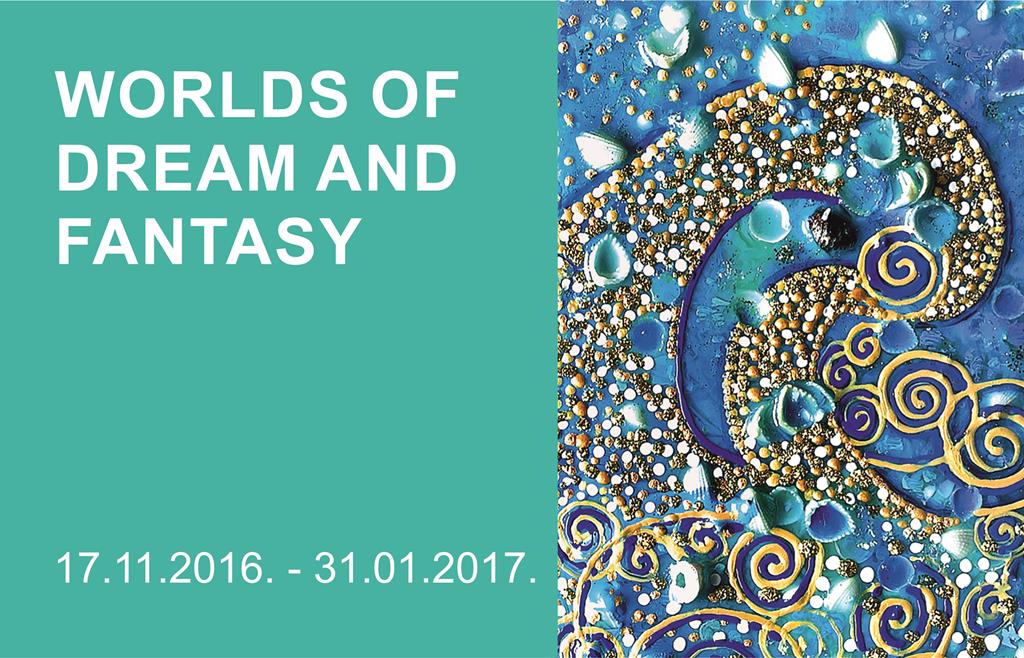Worlds of Dream and Fantasy An International Group Exhibition

Curators: Nour Nouri, Māris Čačka
… ……………………………………………………………………………………………………………
Curatorial Statement
We all have had dreams from childhood till now. This realm of dreams has long been the subject of interpretation from classical antiquity. Apart from medieval manuscripts on interpretation of dreams, Freud’s seminal work lent a high significance to dreams in psychology. In a simple general sense, we dream when we are sleeping or daydreaming and it is then that the iceberg of the unconscious starts to appear more on the face of the deep sea of psyche. Fantasy, in a very simple definition, is the creative imagination. While we generally think that the borderline between sleep and wakefulness is clear-cut, it is actually not so. The unconscious is always present at work in its mysterious ways. In dreams we are closer to truth since we are on a higher state of mind.
It is therefore, the active cooperation between conscious and the unconscious which makes us creative beings. A dream is an intangible thing and when artists visualize their dreams in art, they embody the intangibility of dreams.
The art works which are selected especially for this exhibition are in one way or another the outcome of the dreams and fantasy of artists from different cultures. While they are all different from each other in terms of subjects and even techniques, they all tell the dreams or daydreams of the artists. By viewing the works of each individual artist, you enter a separate world of dream and fantasy, as if you enter a new world “Through the Looking Glass”.
……………………………………………………………………………………………………………………………………………………
Participating artists:
Lisa Etterich (Germany) compresses all her experience to create structural paintings which immerse the viewer into a fantasy world. They are abstract, metaphysical and cosmically-inspired works that visualize versatility of her imagination. Mythological scenes, dream-scapes, artful topographies which appear as satellite images of another world, all make an outstanding oeuvre. Pashmin Art published her art book “A Journey into Neverland” (2016) in English, Chinese, and German.
Zhehu Li (China) is the professor and research supervisor in the school of art and design of Shanghai institute of technology. He was awarded the title of “Outstanding Artist of Nation” by China council for the promotion of ethnic art of Chinese artists in 2001. His semi-realistic paintings make a quick magical impression on the viewer with his individual style.
Dminc (Italy) lives and works in Milan after a life of traveling. She is a nonconformist and lover of Zen. She constantly breaks the mold and goes beyond the limits of “already seen” or “said”. Life and the great 19th century masters were her teachers. The techniques she learned in fashion characterize the three-dimensionality in her later works. Acrylic paints, pastes, glitters, powders, shells, swarovski crystals, and many other objects find their way on her paintings.
Natalja Nouri (Latvia) now lives and works in Hamburg. Her art is defined by the concept of “Nature Mysticism and Symbols – Alchemy of Cultures”. In her work, cultures, beliefs, symbol languages and religions of the East and the West meet. Microcosm and macrocosm are inextricably linked in her symbolic works characterized by overt or covert symmetric structures.
Patrick Bubna-Litic (Austria) studied political science in Perth and Canberra and discovered his passion for art soon. He transfers musical tones in colors and shapes. The movements of his spatula and brush are like the movements in musical pieces. He creates landscapes of the soul. His paintings are full of luminosity and express vitality, passion and a peaceful disposition. Pashmin Art published his art book “The Color of Music” (2015) in English, Chinese, and German.
Michael Imhof (Germany) is a surgeon. Dr. Imhof’s mind is occupied with fundamental ethical philosophical questions of the 21st century medicine and he tries to put these questions in his artistic activity. In his art Imhof creates images of a world that is imbued with spirit. People stand in the center of the mystery of life. He sometimes connects human, animal and machine together in his art to replicate the presence of machinery and artificial genetics in his art.
Jiang Haicang (China) was born in ancient Zhouyuan (Qishan County, Baoji City, China) where there is a loessland. It was the fantasy, grotesque and profoundness of the loessland that overwhelmed Jiang Haicang’s heart and soul, which contributed to the harmony between human and nature, primitive atmosphere and abstractness in his later works.
Ymmerwahr (Germany) whose real name is Karola Pegau, discovered her passion for oriental culture in her trips to Iran and Afghanistan. The viewer can detect a reflection of the visual impressions and experiences in her paintings. The bright sun, vivid colors and the abundance of light personalize her works. Her dreams and professional knowledge in fine design combine forces to create a new series of art works.
Janus Alphonso (Germany) focuses on realistic cranes and bridges as his major motifs in cityscapes. He shows industry representations in harmony with nature. His cranes do not intervene in nature and do not destroy the scenic beauty. On the contrary, the artist is not only directed to an idealized world, but concretely shows the industry-evoked changes in the relationship between man and nature in the 21st century.
Hou Guanbin (China) graduated from the Academy of Fine Arts of Hebei University in Beijing. His works visualize a new sculptural aestheticism via anti-elite and humorous techniques. Irony is his main theme. He deconstructs the popular culture in three ways: doubting and criticizing the reality comically, molding a world of contradiction and paradox, and avoiding the high design language







